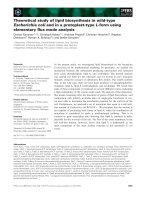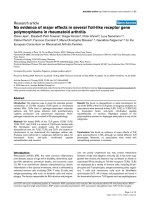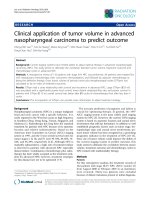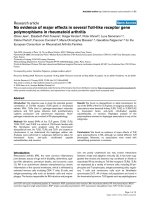Theoretical investigations of thermoelectric effects in advanced low dimensional materials
Bạn đang xem bản rút gọn của tài liệu. Xem và tải ngay bản đầy đủ của tài liệu tại đây (5.77 MB, 128 trang )
THEORETICAL INVESTIGATIONS OF
THERMOELECTRIC EFFECTS IN ADVANCED
LOW DIMENSIONAL MATERIALS
HUANG WEN
(B.Sc., National University of Singapore)
A THESIS SUBMITTED
FOR THE DEGREE OF DOCTOR OF PHILOSOPHY
DEPARTMENT OF ELECTRICAL AND COMPUTER
ENGINEERING
NATIONAL UNIVERSITY OF SINGAPORE
2014
DECLARATION
I hereby declare that the thesis is my original
work and it has been written by me in its entirety.
I have duly acknowledged all the sources of
information which have been used in the thesis.
This thesis has also not been submitted for any
degree in any university previously.
_________________
Huang Wen
14 February 2014
ACKNOWLEDGEMENTS
i
Acknowledgements
I would like to express my most sincere gratitude and deepest
appreciation to my supervisor, Assoc. Prof. Liang Gengchiau, for his guidance
and support throughout the course of my PhD at NUS. It is because of his
expertise, understanding and patience that help me overcome the difficulties
during my graduate study. Without his supervision and encouragement, this
research work would not be possible.
I would also like to thank Prof. Wang Jian-Sheng from Department of
Physics, Dr. Lan Jinghua, Dr. Gan Chee Kwan, Dr. Quek Su Ying and Dr. Luo
Xin from the Institute of High Performance Computing for their lively
discussions and valuable advices during the collaboration. I am also grateful to
my qualifying exam committee, Assoc. Prof. Mansoor Bin Abdul Jalil and
Assoc. Prof. Lee Chengkuo, for their insightful comments and suggestions.
It is a pleasure to thank all my colleagues in the Computational
Nanoelectronics and Nanodevices Laboratory who made my research life
memorable with their help and friendship. In particular, thanks to Dr. Lam
Kai-Tak, Dr. Da Haixia, Dr. S. Bala Kumar, Dr. Zeng Minggang, Dr. Chen Ji,
Mr. Qian You, and many others for their helpful inputs and discussions.
My heartfelt thanks go to my parents for their unconditional support, faith,
and love. Finally, my special thanks to my husband, Yu Honghai, for the
constant encouragement and always staying by my side.
TABLE OF CONTENTS
ii
Table of Contents
Acknowledgements i
Summary v
List of Tables viii
List of Figures ix
List of Symbols xvi
Chapter 1 Introduction 1
1.1 Background 2
1.2 Objectives 10
1.3 Organization of Thesis 10
Chapter 2 Methodology 12
2.1 Energy Dispersions 13
2.1.1 Tight-binding model 13
2.1.2 Fourth-nearest-neighbour force constant approach 18
2.1.3 First principles density functional theory 21
2.2 Transport Properties 22
2.2.1 NEGF approach 22
2.2.2 Ballistic method based on Landauer approach 25
Chapter 3 Thermoelectric Properties of Ge nanowire s 29
3.1 Introduction 29
3.2 Simulation Set-up 30
3.3 Results and Discussions 30
3.3.1 Geometry effects on thermoelectric performance of Ge NWs 30
3.3.2 Comparison between Ge and Si NWs 35
3.3.3 Temperature effect on thermoelectric performance 38
3.3.4 Packing effect on thermoelectric performance 39
3.4 Summary 42
Chapter 4 Thermoelectric Properties of Graphene Nanoribbons 43
TABLE OF CONTENTS
iii
4.1 Introduction 43
4.2 Simulation Set-up 44
4.3 Results and Discussions 45
4.3.1 Thermoelectric properties of perfect GNRs 45
4.3.2 Thermoelectric properties of chiral GNRs 47
4.3.3 Characterizations of energy dispersions for kinked GNRs 49
4.3.4 Thermoelectric properties of kinked AA-GNRs 52
4.3.5 Thermoelectric properties of kinked ZZ-GNRs 54
4.3.6 Thermoelectric properties of various kinked GNRs 57
4.4 Summary 59
Chapter 5 Thermoelectric Performance of MX
2
Monolayers 61
5.1 Introduction 61
5.2 Simulation Set-up 62
5.3 Results and Discussion 64
5.3.1 Electronic and phononic band structures of monolayer MX
2
64
5.3.2 Thermoelectric properties of monolayer MX
2
66
5.3.3 Temperature effects 70
5.4 Summary 75
Chapter 6 Thermoelectric Properties of Few-layer MoS
2
and WSe
2
76
6.1 Introduction 76
6.2 Simulation Set-up 77
6.3 Results and Discussions 80
6.3.1 Choice of exchange-correlation functional for electronic band
structure calculations 80
6.3.2 Electronic band structures and transport properties 82
6.3.3 Phonon dispersion and transport properties 86
6.3.4 Thermoelectric performance 87
6.3.5 Temperature effects 90
6.5 Summary 94
TABLE OF CONTENTS
iv
Chapter 7 Conclusion and Future Works 96
7.1 Conclusions 96
7.2 Future works 97
7.2.1 Transport properties of graphene with grain boundaries 97
7.2.2 Thermoelectric performance of topological insulators 100
References 102
List of Publications 108
SUMMARY
v
Summary
For the continued realization of scaling down in minimum feature size
according to Moore’s law, nanostructure devices have attracted growing
attentions due to higher capability and integration. At the nanoscale, quantum
confinement effects can be observed, and the conventional theory is no longer
valid for the energy carriers, therefore, the theoretical assessment of the carrier
transport properties is essential for nanostructured materials. Moreover, the
topic of thermoelectric effect, which is the conversion between heat and
electric voltage based on both electron and phonon transport, becomes
increasingly important as people strive to develop technologies to improve
energy efficiency. Hence, this thesis theoretically studies the intrinsic ballistic
electron and phonon transport properties, especially with a focus on the
thermoelectric performance for novel nanostructured materials beyond silicon.
Firstly, semiconducting one-dimensional Ge nanowires are studied. In the
ballistic regime, their transport and thermoelectric properties are greatly
influenced by geometry effects. The Ge nanowires along [100] direction have
better thermoelectric performance in terms of power factor. For extremely
small nanowires, the effect of cross-sectional shape is also significant.
Comparing the results between triangular Ge and Si nanowires with 1 nm side
length, n-type Si nanowires outperform Ge nanowires due to higher number of
subband valleys contributing to the electron transport.









